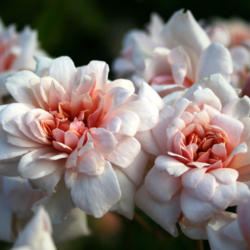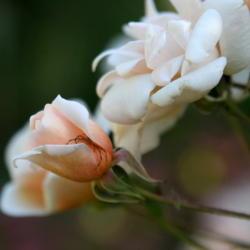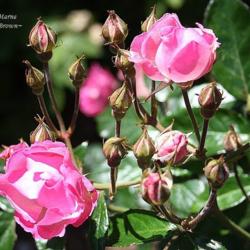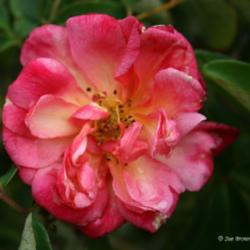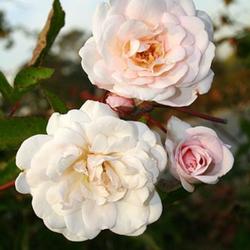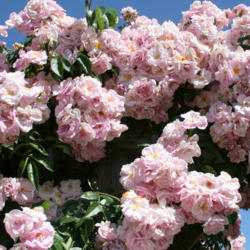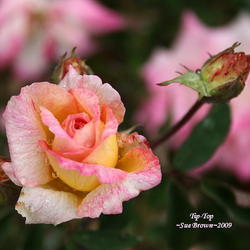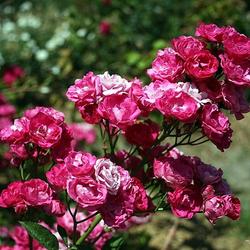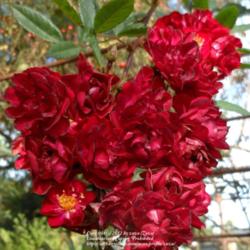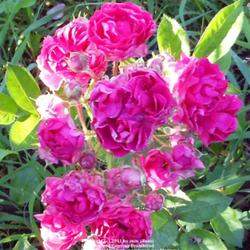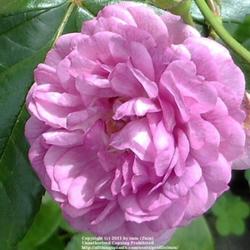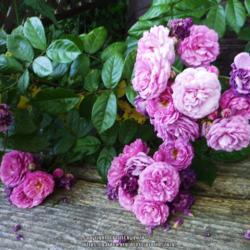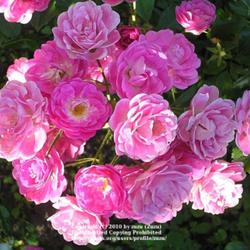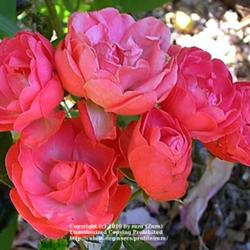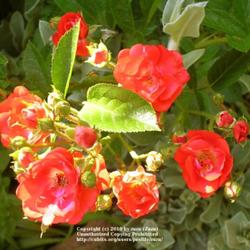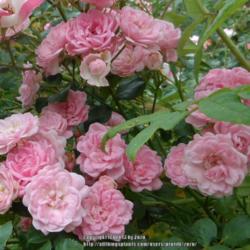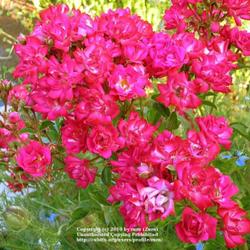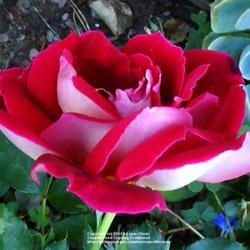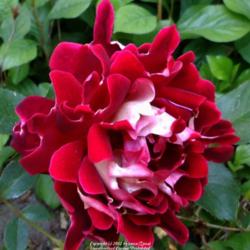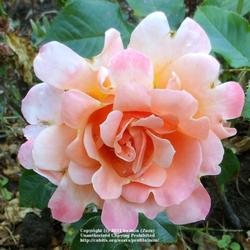The earliest Polyanthas -- 'Paquerette' (bred 1872), 'Mignonette' (bred 1875), and 'Anne-Marie de Montravel' (bred 1879) were essentially dwarf repeat-blooming hybrids or Rosa multiflora. The other parent was likely a dwarf repeat-blooming China -- like 'Rouletii' or one of the other Lawrancianas, which were essentially Chinas that had a dwarfing mutation, in addition to the reblooming mutation found among other Chinas. As they continued to be bred, it seems some were raised which lacked the dwarfing mutation but retained the reblooming mutation. These Polyanthas were a bit larger in plant size than the earlier ones, but still retained a bushy rather than climbing habit. Also, the earliest were either white, but as they were bred with red and pink Chinas, their colors expanded. Later, some dwarf repeat-blooming sports of Multiflora Ramblers -- 'Tausendschon' is one example of a Rambler that begat a line of Polyantha sports -- appeared, and they, too, were known as Polyanthas. Still later, Polyanthas were bred using Rosa wichura(ia)na, which brought glossy leaves, a bit more of a lax habit, and less shade tolerance than the R. multiflora-derived Polyanthas.
So that's a very basic history of the origin of Polyanthas. But what are they? Essentially, they are small to medium shrubs which bear small flowers in large clusters, and bloom repeatedly. They tend to be a little more cold-hardy than Chinas, and so began to overtake them as "everblooming roses" in the late 19th and early 20th Centuries. This led to them being used for bedding -- planting beds of one variety massed together. They started to fade from popularity as they were bred with Hybrid Teas in the early 20th Century to expand color range and make larger flowers. At first, these were known as Hybrid Polyanthas, or Poulsen Roses in reference to the Danish breeder who first made these crosses. Over time, a new class was created to accommodate them -- the Floribundas. Yep, today's popular cluster-flowered class of roses goes back to the Polyanthas.
Early on, there was a small side-branch of the Polyanthas -- the Poly-Teas. Just as the Chinas had the repeat-blooming mutation, so did the Teas. They differed in that Chinas tended to be smaller and less fragrant, but in darker colors like pink and red. Teas tended to be larger and more fragrant, and in paler, translucent colors, including pale yellow and peach-apricot shades. When Teas were crossed with the early Polyanthas, the resulting offspring were stouter, had pointed buds of the Teas, but blooms were much smaller and held in large clusters. The most well-known of this side-branch is 'Mlle Cecile Brunner' (bred before 1880), aka 'The Sweetheart Rose', which originated from crossing a pink Tea with an early Polyantha. But there's another, possibly slightly earlier rose that is similar, except that its Tea parent was yellow. This Poly-Tea is 'Perle d'Or' (bred 1875), sometimes aka 'Yellow Cecile Brunner'.
2018:



2017:






2016:


For me, here in central NJ zone 7, this rose took a little time to get going since coming as a band in 2013. Part of that was my ignorance at the time -- when I dead-headed it, I followed "book advice" for modern roses and cut it back to the first set of five leaflets. If you look at the pics above, you'll see that this rose sends up large "candelabras" of blooms on rather naked stems, often as new basals, still soft but already terminating in a cluster of up to 20 burds. Cutting down to the first set of five leaflets after the blooms faded meant removing a lot of growth, so poor 'Perle d'Or' remained rather small for the first two years. It wasn't until I was too busy to dead-head for a bit that I saw how this rose grows. Sprouting from otherwise naked candelabra stems -- where I couldn't see any growth buds previously -- were new shoots. So, from then on, rather than dead-heading back to a five-leaflet set, I'd just snap off the faded blooms at the tip, and leave those naked candelabra stems. Rather soon after, I'd find new shoots on many of them. Then I'd decide which to retain -- generally, the outer ones, so as to guide growth into a sort of inverted traffic cone shape -- and cut back the rest. Over the next few years, this has resulted in the shape you see in the pics above.
For me -- and for many others elsewhere -- this rose is bullet-proof, so long as you aren't in a zone colder than about 6. It gets no blackspot or mildew even without using fungicides, blooms in repeated waves with very little down-time in between and continuing until repeated hard frosts knock it to sleep, has a light and sweet scent that isn't strong up-close but floats far on the air, and is a pleasing shade of apricot fading to buff that goes with many other colors.
:-)
~Christopher











